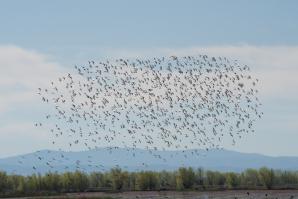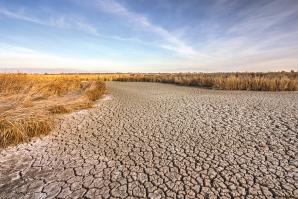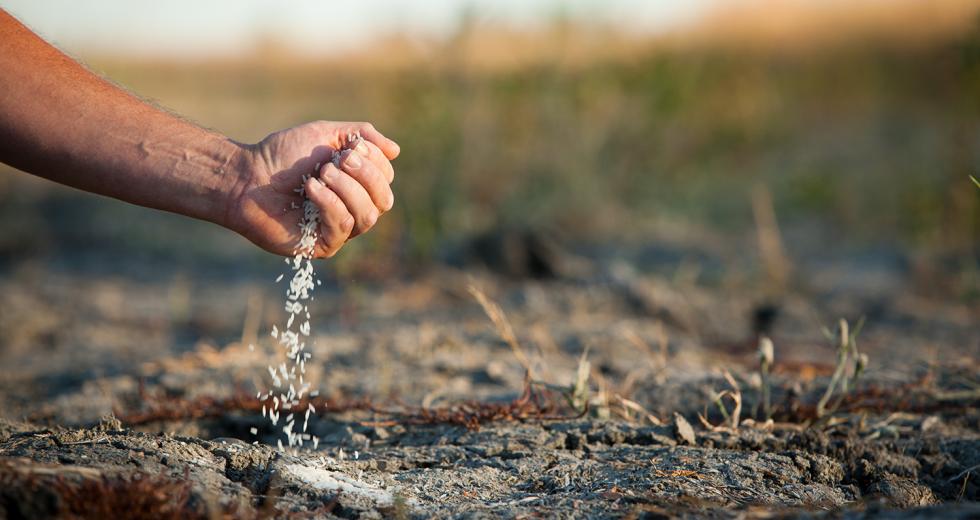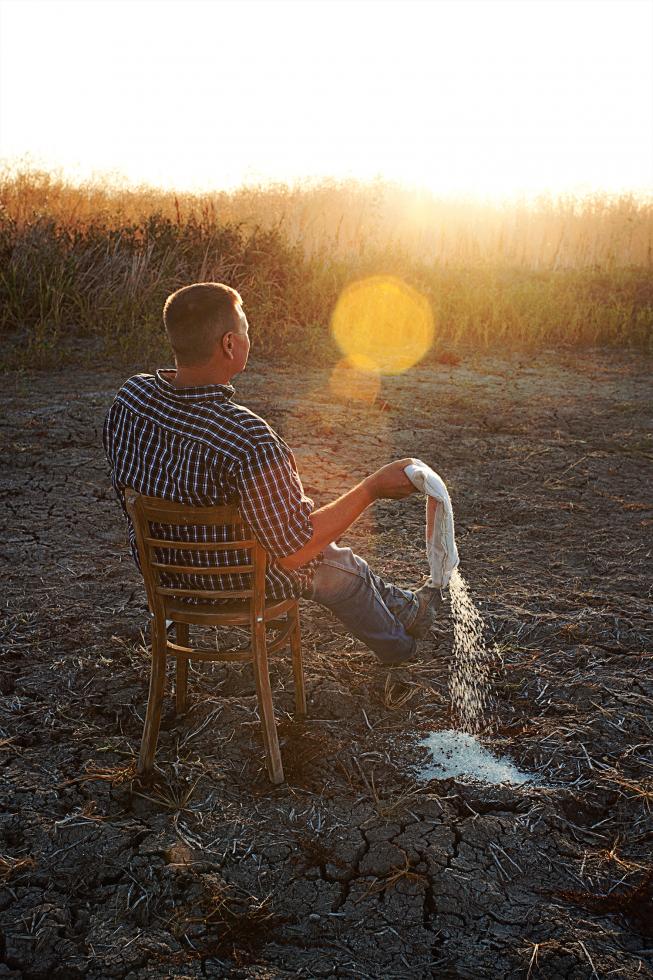On a clear morning in mid-May, Mike DeWit thinks he hears a low-flying plane over a nearby ranch. It is nearly 6 a.m., with the sun rising over a rural patchwork of Elverta rice fields.
“Did you hear something?” he asks, peering from under his weathered Colusa Rice Co. ballcap. But the sky is empty and blue. The only sounds come from a flock of killdeer and DeWit’s chocolate lab, Mochi, splashing about in the groundwater gushing from an old well.
“Around this time, the sky’s usually full of planes,” says the lifelong rice farmer. “I thought there would at least be one. Guess not.” DeWit had, the week before, hired a plane to scatter his seeds. Maybe all the other area farmers are finished, too. At any rate, this case of absent planes reflects the ripple effect of California’s 3-year drought and the plight of one of its victims: rice farmers. Together they will lose about 100,000 acres of rice production this year due to lack of water. That’s about one-fifth of the state’s entire crop, says Jim Morris, spokesman for the California Rice Commission.
In the Sacramento Valley, where 97 percent of the state’s rice crop is grown, family farmers have been forced to fallow cropland they have worked for generations. Average consumers may not have noticed that the cost of rice has increased nearly 15 percent, since it equates to just a few additional pennies per bag. But for producers, the economic hit has been hard and true, affecting not just farmers, but seed distributors, equipment dealers and anyone else with a thumb in the rice business. The drought could cost Central Valley farmers and communities $1.7 billion this year and may lead to more than 14,500 layoffs, according to preliminary results of a study by the UC Davis Center for Watershed Sciences.
“My dad started farming on his own in the early ’70s, and he’s never seen anything like this,” DeWit says. “Even with the drought back in ‘76 and ‘77, there were no severe water cutbacks. And now we have less water and more people.”
The shortage cost him about 30 percent of his acreage, he says. Like other farmers, he has had to pump the more expensive groundwater to compensate for the lack of surface water.
That morning in May, on his father’s 550-acre ranch, DeWit completes his dawn routine of checking pumps, adjusting dams and manipulating flood levels to keep seeds from drying out. Right now, the water in the field is about 4.5 inches deep. But the four wells keep pumping up water, which rolls down the land to cover exposed patches of mud. That mud needs to be covered, lest the weeds sprout, killing a crop he cannot afford to lose.
“The easiest thing about rice farming,” he says, “is to just remember: Water goes downhill.”
All Downhill From Here
Water distribution in the Sacramento Valley runs on a trickle-down system. As the water flows from the mountains to the ocean, the state’s Water Resources Board manages allocation, giving priority to senior rights holders (farms and communities established before 1914), then junior rights holders (cities, businesses and farms established post-1914) and so on until the water reaches the sea.
For a better visual, California Rice Commission CEO and president Tim Johnson pictures a wine-barrel fountain. The small, top barrel gets filled first, then once it overflows, the water falls down to the larger second tier, then the third. But what happens if no barrels ever get filled? That‘s exactly what happened in January, forcing water resource managers to change the allocation strategy so users down the waterway would get something instead of nothing.
It Could Have Been Worse
Fortunately, rainfall in early spring helped improve, however slightly, the bleak water situation, which Johnson says will make this year tough but not tragic. On a global scale, 100,000 fallowed acres is not too big a blow, says Chris Crutchfield, president and CEO of American Commodity Co. The southern rice-producing region of the U.S. (Arkansas, Louisiana, Mississippi, Missouri and Texas) has increased production by more than 700,000 acres this year, and more than 20 percent of that is medium-grain rice.
“There will actually be more medium-grain and more total rice produced in the U.S. in 2014 compared to 2013,” Crutchfield says. “While the southern medium-grain is inferior in quality to the Calrose grown here in California, it is a sufficient replacement for one year in some markets, like the Middle East and North Africa.”
And California farmers will still produce enough rice this year to more than supply the traditional markets of North America, Japan, South Korea and Taiwan. A major exporter, the U.S. produces only 2 percent of the world’s rice but accounts for more than 10 percent of the global rice trade. Since the mid-1990s, trade agreements under the World Trade Organization (WTO) and the North American Free Trade Agreement (NAFTA) have helped increase U.S. rice exports. But some local farmers are concerned about the future with our neighbors overseas.
“We still have obligations to fulfill for other countries,” says Nevada Smith, who has a 700-acre ranch in Yuba City and exports about 70 percent of his crop. “If we don’t get our acres back up, our reservoirs will be gone and we won’t be able to honor those contracts.”
In February, Smith got a phone call saying the water district would be purchasing 38 percent of his water. He had no say in the matter. He says the district told him reservoirs were low and it needed the water for health and safety purposes like forest fires and fresh water for residential areas. Financially, it’s an undisputed loss, but the increased price of rice “definitely won’t make the loss hurt as bad,” he says.
Up in the town of Colusa, Don Traynham usually starts land preparation at the end of March but this year had to push back his schedule a month because he had no clue how much water was coming his way. He farms in four different districts. In three of them, he received 100 percent of his allocation, but in one, he received only 35 percent. He knows the cutbacks were overdue.
“On average, we should have a cut every 10 years or so,” he says. “It’s been 16. Is it a hardship? Yes, absolutely but we’re not complaining. We have to adjust to survive.”
Machine vs. Nature
The ripple effect does not end in the rice field. With the drought forcing more farmers to grow less rice, equipment dealers must face the reality of reduced sales.
Valley Truck & Tractor, based in Yuba City, sells rice combines, four-wheel drive tractors, different types of field discs, sprayers and “anything a rice grower might need to get the crop,” says John Miller, the company’s president. But no crop means no workers hired to manage the crop, which means this equipment might end up sitting around the showroom with nowhere to go.
“We’ve taken the time to adjust our inventories accordingly to reflect acres of fallowed ground,” he says. “Obviously, you’re not going to buy a $300,000 tractor if you don’t know if you’re going to be growing any rice this year.”
In March and April, whole goods sales were down by 40 to 50 percent (although, the parts and service business was level), Miller says. This is primarily due to the rice problem. The company has cut back 50 percent on orders for new rice combines for harvesting. Rentals, however, have gone up 20 percent this year, mainly because the option to rent for 30 days takes away some uncertainty.
“A lot of that was because of the fear factor, uncertainty of the unknown with water allocations in the North Valley,” Miller says. “Since May 1, the rice growers have gotten their allocations, so they know what they’re going to be able to plant and not be able to plant.”
To cover losses, the company has made efforts to control expenses: less overtime, less travel, less hiring, etc. Valley Truck & Tractor, which opened in 1948, experienced drought in the mid 1970s. But nothing this dramatic, he says. Overall, Miller thinks most rice growers and farmers in the Sacramento Valley will get by fairly well this year.
“The big question will be if we have another drought next year. It will be a real game-changer in the whole agriculture industry,” he says. “We’re keeping our fingers crossed for a good snow pack and lots of rain this fall and winter.”
Good Growth
Since the age of seven, DeWit has wanted to follow in his father’s muddy footsteps. He helped out on his dad’s ranch most of his life, avoiding the business aspects. Then in 2009, he branched out on his own and gained a new appreciation for his father’s ability to manage the ranch’s tax planning, budgeting, cash flow and human resources.
All those business factors he hated growing up now have roared down upon him. This year he had to let go of his tractor driver, Antonio, who had been with him for five years.
“I had to tell him I didn’t have work for him,” he says. “It was a decision I had to make even though I didn’t want to. I’m hoping he’ll be back for harvest, hoping he found a job with another farmer, but I haven’t heard from him. That’s another tragedy of this California drought.”
DeWit plans to keep producing, despite these setbacks. And he always keeps in mind his father’s advice from years ago, written on a Post-It note he keeps in his home office: Any dummy can grow rice. The guy that stays in this business is the guy that can manage his risk successfully.
Don’t want to wait? Get all your Comstock’s at the start of the month by becoming a print subscriber.
Recommended For You

Water Foul
The drought is putting in jeopardy efforts to shore up migratory bird populations
Doug Thomas stops his white pickup along the elevated dirt road that carves through the acres of newly planted rice stalks in Wheatland, Calif.
In this scene, replete with a myriad of migratory birds lazily grazing in the green fields, change is soon to come. The landscape, Thomas says, will be transformed into an oasis for waterfowl and shorebirds that will find a man-made wetlands to call home on their annual migration this fall.

Got Storage?
California can't conserve its way out of a drought
Years of drought have baked away some of the divisions inside California’s Capitol, drawing opposing parties together in an effort to find solutions to the state’s ongoing water storage and conveyance problems.

Dry Times
New water storage alone won't solve California's drought
California is in the third driest year in more than 100 years of record. Farmers throughout the state are seeing their water use curtailed, some communities are rationing water, and fish and wildlife populations are threatened. California needs additional storage capacity to weather such droughts, and it’s groundwater storage — not surface storage — that will have the greatest impact. Still, storage alone won’t be enough.

Change of Plans
Regional conservation efforts battle dwindling budgets and staff
The future of community growth in the Capital Region hinges on the fate of several habitat conservation plans slogging through the development pipeline.





Comments
I am curious to know why the state is pursuing "the Tunnel Project", sending water down south but yet our farmers right here in Nor Cal that the water runs right by, cannot get their needs met. I understand that there are different crops in the south end that are equally vital, but who decides who gets to prosper as a farmer and who doesn't. In regards to water shed or ground water rights, how's it possible that a farmer in So Cal has rights over our Nor Cal farmers?